
This is everything you need to know about chicken of the woods.
North America’s mushroom hunting season doesn’t have to be strictly confined to the spring months looking for morels. The late summer and fall months are the ideal time to find chicken of the woods mushrooms.
Never heard of them? These mushrooms are so named because, well, they taste like chicken!
We know, it sounds crazy, but some people even refer to these wild mushrooms as a “chicken substitute.”
Here’s all you need to know about these edible mushrooms, from how to find them to some ideas on how to prepare them.
What is chicken of the woods?

This mushroom consists of a few different subspecies in the Laetiporus genus. Unlike morels, which can be tricky to spot, chicken of the woods usually sticks out like a sore thumb when fruiting, especially in late summer when everything else in the woods is still green.
This is thanks to the vibrant, bright yellow and bright orange color patterns that are common. It also grows quite large, in a shelf-like structure that is hard to miss.
Just one mushroom can yield several pounds of edible material. Hunting for these is time well spent in the woods; you’re able to pick up meals for a few days for practically nothing.
As we mentioned earlier, there are several different subspecies. Mushroom hunters refer to most of these species under the umbrella terms “chicken of the woods,” “chicken fungus,” or “sulphur shelf” monikers. To really differentiate between them is to refer to them by their scientific names. The species you’re most likely to find in your area depends on where you’re searching.
For instance, Laetiporus gilbertsonii is found mostly in California. Similarly, Laetiporus conifericola seems to be confined mostly to western North America’s coastal regions. Laetiporus sulphureus on the other hand, seems to be the most commonly found in the more eastern parts of the United States and Canada. If you live in the Great Lakes area like I do, you’re likely going to be finding Laetiporus huroniensis.
In truth, the species are very similar in appearance and many times, flavor. In fact, mycologists (scientists who study fungi) are continually finding new sub species of Laetiporus throughout the world. Laetiporus ailaoshanensis was discovered to be a new species in China in 2014 and a Caribbean and Central American variety known as Laetiporus caribensis was only discovered to be a unique species in 2012.
How to identify chicken of the woods
With any sort of mushroom hunting comes concerns about similar-looking species. Fortunately, you don’t need to be an expert mycologist in order to figure out if you’re looking at the real McCoy or not, nor do you need to identify the exact genus in order to eat them.
As we’ve already noted, many species of chicken mushrooms are extremely brightly colored. These colors vary from orange and “sulfur” yellow to pink or simply white. The fungus often grows in huge, cool-looking brackets or shelves. You’ll find the terminology varies from place to place among mushroom hunters.
When you think you’ve found a Laetiporus, look at the underside of the “shelf” portion of the fungus. There should be some obvious pores there. If you find something that appears to have lines or “gills” as some hunters refer to them, you’ve likely found a look-alike.
Speaking of look-alikes, this is one of the great things about Laetiporus. There aren’t many different species you can mix it up with. Probably the closest-looking species of fungi is chanterelle with a similar-looking fruiting body.
The good news is, even if you do mix these two species up, it’s perfectly fine because the chanterelle is edible too.
The main giveaway is that chanterelle grows directly out of the ground while Laetiporus is almost always found on a host tree, sometimes living, but usually dead (more on that later).
Another common mix-up is Grifola frondosa, also known as “hen of the woods.” It has similar shelves to Laetiporus but is often darker in coloration.
For the most part, you’ll find chicken of the woods to be a very safe species of mushroom to look for, especially for first time mushroom hunters.
Where to find chicken of the woods
Another great thing about this fungi is that it’s very easy to find. In fact, you’ve probably walked right by it many times in the past without realizing it.
I admit, it didn’t look like the sort of thing I would think was edible the first time I saw it.
Chicken of the woods prefers dead or dying trees. Look anywhere there are fallen logs or exposed root systems. Most serious hunters swear that oak trees are Laetiporus’ preferred type of wood, but the fungus is often found on all types of trees from August and into October. It gives us something extra to look for during early hunting seasons!
There are some issues with foragers about the species of tree a chicken of the woods mushroom is attached to. Most hunters will not eat Laetiporus that was found on conifers like yew or cedar. The same goes for more uncommon species like eucalyptus.
Remember that this fungus can be parasitic at times and will absorb things from the tree it is on. The general thinking here is that the type of tree directly affects the flavor as the fungus may absorb some oils or sap from the tree.
These oils and saps will make the edibility much worse. There are even some reports that if you eat chicken of the woods off the wrong tree, it could be poisonous. As a way to completely avoid that, just stick to oaks and hardwoods. As an additional safety precaution, if the mushroom doesn’t look right or smells rotten, don’t eat it!
How to collect a chicken of the woods mushroom
When you harvest chicken of the woods, cut them from the tree cleanly as close to the base as you can.
Leave a little bit of the root portion still embedded in the stump, log or tree. Sometimes this species returns after being cut off, meaning you can count on a tasty treat in the same area season after season!
Keep your collected mushrooms in a soft mesh bag, or something that won’t crush or bend them. Give them a wash when you return to your kitchen, and they can be stored in a paper bag in the refrigerator for about a week.
How to prepare chicken of the woods
There is a plethora of ways to prepare chicken of the woods. The simplest method is to roll with the meaty nature of this fungi and simply treat it like chicken.
Cover it in butter, olive oil or egg and flour/breadcrumbs and then fry it in a pan. Using this technique, you’ll find once cooked, it really does look like fried chicken (or sometimes even fried fish). Who would have thought?
Feel free to get creative and use chicken of the woods in a place where you would traditionally use poultry. Many people like to make sandwiches or sautéed side dishes of these mushrooms this time of year. You can also freeze it and save it for later if you’d like. Most seasoned mushroom hunters will recommend sautéing the mushrooms before you do this to help lock in the flavor.
When cutting up your chicken of the woods, keep in mind that the “shelf” portion of the mushroom is the part that is the most edible. The stem portions can be a little bit too tough and you might want to remove those and discard them.
Also, be careful when cleaning or adding oils to these. Remember they are a mushroom and they have tendency to absorb liquids. Too much could affect the taste.
One last important thing that bears mentioning is safety. Most experts recommend starting slow when eating chicken of the woods, only because this mushroom sometimes causes allergic reactions in people who didn’t know they had an allergy previously. Try eating a small piece first and waiting a while, just to make sure you don’t react negatively to it.
Chicken of the woods is one of the more unique and lesser-appreciated mushrooms out there. Keep an eye out during your outdoor adventures this fall. You may just find a tasty treat growing on an old stump in your favorite section of woods!
For more outdoor content from Travis Smola, be sure to follow him on Twitter and check out his Geocaching and Outdoors with Travis Youtube channels.
NEXT: MOREL MUSHROOM HUNTING IS HEATING UP IN A FEW POCKETS OF THE COUNTRY
WATCH
The post Chicken of the Woods: Everything You Need to Know About This Wild Mushroom appeared first on Wide Open Spaces.















